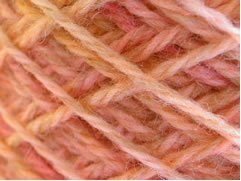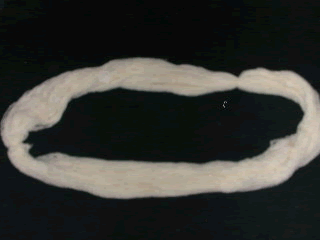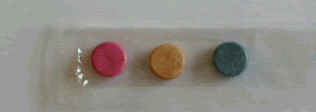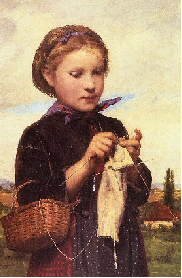What Knitting Machines Can Do
Dec 27th, 2009 Posted in articles | Comments Off on What Knitting Machines Can Doby Sonja Kathleen
Automatic Stitch Techniques
Modern knitting machines can perform a variety of interesting stitch techniques without a ribber or garter carriage. These include fair isle, tuck, skip, normal lace, fine lace, thread lace, weaving, plating, and intarsia. Some of these are identical to their hand knitting counterparts; others are unique to knitting machines.
Each type of stitch is accomplished by using one of the four positions for each needle in conjunction with the different cam settings on the knit carriage. The four needle positions are non-working, working, upper working, and holding. Most of the stitch functions are fully automatic, meaning the machine places selected needles in either the working or upper working position with each pass of the carriage, according to the design pattern. All the knitter needs to do is move the carriage back and forth to knit the fabric. These stitch functions are all exclusive of one another; that is to say, they cannot be combined in any one row (i.e. you can’t knit fair isle lace, although you can knit a fair isle body with lace sleeves)
Fair Isle
Fair isle refers to stranded knitting using two colors, just like in hand knitting. The main color knits on needles in working position, and the alternate color knits on needles in upper working position. Although only two colors can be used in any given row, these can be changed from row to row, giving you more options. As in hand knitting, the knitter will want to choose a design that minimizes the floats on the back of the fabric. However, the machine virtually eliminates tension problems with the yarn carried behind.
Tuck Stitch
Tuck stitch doesn’t really have a hand knitted equivalent that I’m aware of. In tuck stitch, the needles in working position knit normally. The needles in upper working position don’t knit, but an extra loop of yarn is laid over them with each pass of the carriage. When these needles are returned to working position, all the loops on the needle knit in a single stitch, resulting in a textured fabric. Tuck stitch uses only one strand of yarn per row, although it can be changed on any row for some interesting color effects.
Skip Stitch
Skip stitch is the machine knitting equivalent of slipping instead of knitting a stitch. In hand knitting, it’s also used to do mosaic knitting. As in tuck stitch, the needles in working position knit and the needles in upper working position don’t. However, no extra loops of yarn are laid over the needles in upper working position, so when the needle finally knits, it’s a single, longer stitch. As with tuck stitch, the yarn can be changed on any row to produce mosaic effects.
Normal Lace
Normal lace is the machine equivalent of traditional hand knitted lace. Also called “transfer lace”, it requires the use of a special lace carriage in addition to the knitting carriage. When the lace carriage is passed over the needles, stitches in upper working position are transferred or moved to adjacent needles. Then, when the knit carriage is passed over the bed, needles with multiple stitches knit normally (the equivalent of “knit 2 together”), and needles with no stitch are cast on (the equivalent of a “yarn over”), creating the characteristic holes.
Fine Lace
Fine lace is a textured fabric that is probably most similar to the effect you get when you twist stitches in hand knitting. It’s worked in exactly the same way as normal lace. However, when a transfer is made, the stitch remains on the original needle while also being stretched onto an adjacent needle. Thus, when the knit carriage is operated, there are “knit 2 togethers” but no “yarn overs” since no needles are empty.
Thread Lace
Also called “punch lace”, thread lace is essentially fair isle done with a regular yarn and a matching thread. Because the thread is so much thinner, it barely shows, making it appear that the fabric has lace holes in it.
Weaving
Weaving is actually a knitted technique using a backing yarn and a weaving yarn. The machine automatically places needles in either the working or upper working position according to the design pattern. The knitter manually places the weaving yarn along the needles in upper working position, and then passes the knit carriage over them. The backing yarn knits normally, but catches in the weaving thread on those needles, forming floats of different lengths on the surface of the fabric. The floats appear as a woven pattern on the wrong side of the fabric.
Plating
Plating is normal stockinette stitch done with two separate yarns. The main yarn knits normally, and the alternate yarn knits behind it simultaneously. This produces a “lined” knit fabric, which is useful if your main yarn is scratchy. The alternate yarn shows through a little bit, giving subtle color variations.
Manual Techniques
Some of the stitch techniques are completely manual, meaning that the machine doesn’t select the needles for you. The knitter must look at a graphed design, select the needles after each pass of the carriage, and perform the manual operation before passing the carriage again. These techniques include intarsia, cables, and hand-manipulated stitches.
Intarsia
Intarsia is the most labor-intensive of the manual techniques. The knitter places each color yarn on the appropriate needles before passing a special intarsia carriage over them. The yarns are threaded through special weights that hang down from the needle bed to help maintain good tension. On some machines, the knit carriage has a special setting so a separate intarsia carriage is not needed.
Cables
Cables can be formed by manually transferring stitches to other needles on the appropriate row. Although a complicated cable pattern can be labor intensive, cables usually work up quickly since the transfer is made on a small percentage of the rows. It can be difficult to work cables wider than 3 x 3, however, since the fabric doesn’t usually have as much give as hand knitting.
Hand Manipulated Stitches
Hand manipulated stitches include twisting, wrapping, weaving, lifting, rehanging and transferring stitches to create textured fabrics. These techniques result in surface embellishments, puckers, relief patterns, gathers, ruching, bobbles, popcorn, pintucks, fringes, and trims, even beading. There is almost no limit to the variety a knitter can achieve.
Pattern Variations
Electronic knitting machines may also include pattern variation buttons that allow the knitter to change a design that’s already been input, either by the knitter or pre-programmed. These include reverse, mirror image, upside down, reflection (vertical mirror image), double width, double length, rotation, negative, multi-color rib (jacquard), and single motif. Using double width and double length together will automatically make your design four times larger without having to re-enter it.
 Photo 1: Overdye using pink and orange dye over a tan/white 2-ply wool yarn (dip-dye method).
Photo 1: Overdye using pink and orange dye over a tan/white 2-ply wool yarn (dip-dye method).





 Wrap your yarn around a pencil, or ruler or any other similar object and count the number of wraps per inch. You can even make a tool with the inch marks indicated on the dowel but a ruler works great too since it’s already marked off. If you’re worried about pulling apart a skein you haven’t purchased yet, just lift up an inch worth of strands away from the skein without disturbing the hold. In this photo I wrapped around a pencil and measured against a ruler. There are 12 wraps over one inch so my WPI is “12”.
Wrap your yarn around a pencil, or ruler or any other similar object and count the number of wraps per inch. You can even make a tool with the inch marks indicated on the dowel but a ruler works great too since it’s already marked off. If you’re worried about pulling apart a skein you haven’t purchased yet, just lift up an inch worth of strands away from the skein without disturbing the hold. In this photo I wrapped around a pencil and measured against a ruler. There are 12 wraps over one inch so my WPI is “12”. 